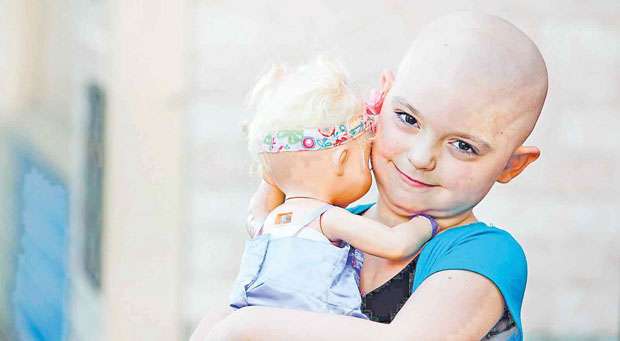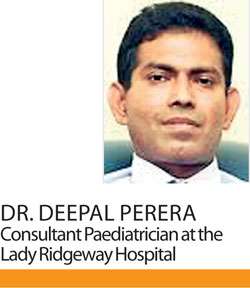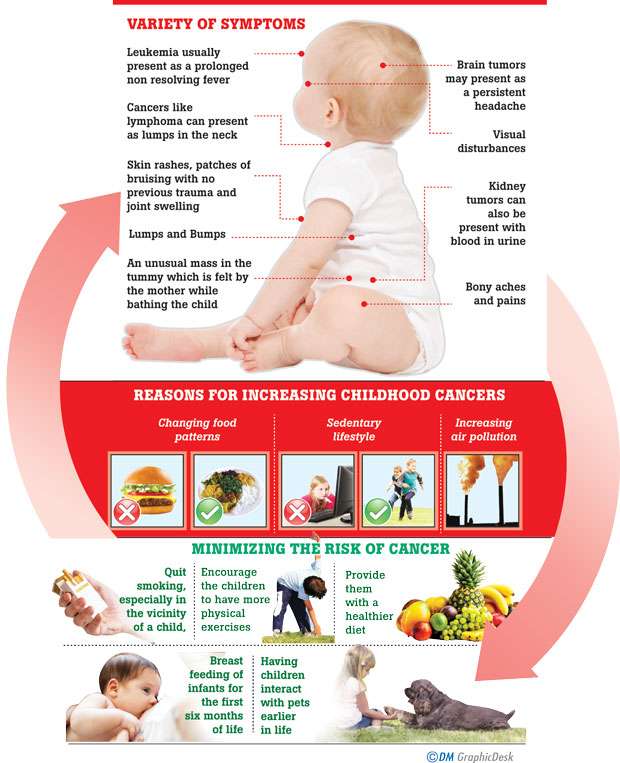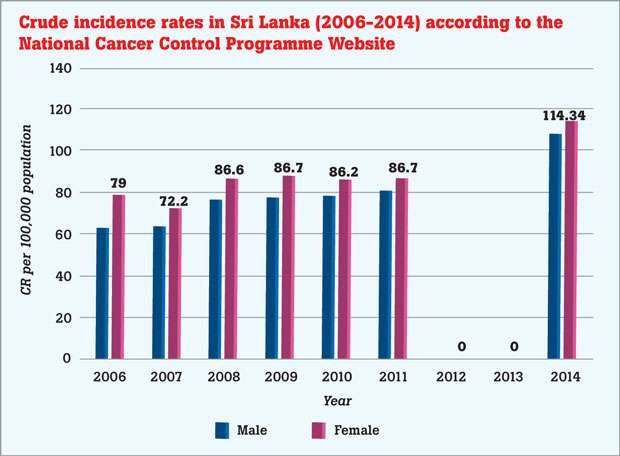Reply To:
Name - Reply Comment

 ‘Cancer’ is a term which strikes fear in the hearts of many, as it does not discriminate when choosing its victims. Young or old, male or female, rich or poor, we are all susceptible to cancer. But there are specific types of cancer patterns that are prevalent among certain groups. Today, on the Day of International Childhood Cancer, we are discussing in depth about childhood cancers and the recent rise in the incidence of cancer in our country. Joining us in today’s discussion is Dr. Deepal Perera, Consultant Paediatrician at the Lady Ridgeway Hospital. Dr. Perera has worked with young patients suffering from cancer for a number of years in his previous appointment as a Consultant Paediatrician at Apeksha Hospital, Maharagama.
‘Cancer’ is a term which strikes fear in the hearts of many, as it does not discriminate when choosing its victims. Young or old, male or female, rich or poor, we are all susceptible to cancer. But there are specific types of cancer patterns that are prevalent among certain groups. Today, on the Day of International Childhood Cancer, we are discussing in depth about childhood cancers and the recent rise in the incidence of cancer in our country. Joining us in today’s discussion is Dr. Deepal Perera, Consultant Paediatrician at the Lady Ridgeway Hospital. Dr. Perera has worked with young patients suffering from cancer for a number of years in his previous appointment as a Consultant Paediatrician at Apeksha Hospital, Maharagama.
Causes
Cancers are usually caused due to a combination of a multitude of factors, explains Dr. Perera. In the paediatric age group, genes have a bigger role to play. Further explaining he states that abnormalities which occurred while inside the uterus can present as cancer during childhood.
Children born with certain genetic diseases like Down Syndrome have an increased risk of getting cancer when compared to other children.
In addition, a variety of factors like unhealthy eating habits, air pollution, exposure to certain radiation and chemicals are believed to be contributors to this disease.
We have witnessed many familial disharmony occurring after a child of the family gets cancer, and parents losing everything including their savings and jobs in taking care of the child
Common cancers of childhood
Leukemia, which is a type of cancer in the blood, is the commonest cancer in childhood. There are a variety of leukemias and among them Acute Lymphoblastic Leukemia (ALL) is more common, followed by Acute Myeloid Leukemia (AML). In addition, lymphomas and cancers of the brain, like meningiomas, medulloblastomas are more commonly seen in paediatric population.
A cancer can occur anywhere in the body, from head to the toe, explains the doctor. Among these, retinoblastoma in the eyes, neuroblastoma in nerve tissues, nephroblastoma in the kidney hepatoma and hepatoblastoma in liver, osteosarcomas in bones and teratomas are some of the other common cancers in childhood.
Initial presentation
Cancer has many facets and therefore a patient with cancer can present with a variety of symptoms. The presentation differs from one type of cancer to another. Leukemias usually present as prolonged non resolving fevers, on and off bony aches and pains, skin rashes, patches of bruising with no previous trauma and joint swelling. In a situation like this, doctors should take caution to exclude malignancy before starting treatment for arthritis or other blood disorders like Idiopathic Thrombocytopenic Purpura, which has a similar presentation, emphasises the doctor. “This is because steroids, which are the treatment of choice in the above mentioned conditions, can cause significant harm if the child turns out to have cancer instead”, he further explains.
In addition, the majority of other childhood cancers can present as ‘Lumps and Bumps’, according to Dr. Perera. A hepatoblastoma or a nephroblastoma can present as an unusual mass in the tummy which is felt by the mother while bathing the child. Cancers like lymphoma can present as lumps in the neck, while brain tumors may present as persistent headache, visual disturbances and sudden onset of poor school performances. Kidney tumors can also present with blood in urine, which is called haematuria.

Investigating the cancer
Blood investigations, imaging like CT and MRI and PET scans as well as samples from the tumor, are some of the investigations used in diagnosis of cancers. In addition, a sample from the core of a hip bone, which is called a bone marrow biopsy, is very useful in diagnosing leukemia, since the blood cells originate in the bone marrow.
Treatment
Treatments for cancers are advancing every day, with more sophisticated methods of treatment being developed one after the other. As a result, the numbers of survivors of cancer are increasing day by day. Even though we have a long way to go until we reach optimum levels of survival, Sri Lanka has an especially good rate of cancer survival when compared with other developing countries, especially when it comes to cancers like ALL, declares Dr. Perera.
Treatment of cancer is a complex process and should involve a multidisciplinary team involving a number of medical specialities. Paediatricians, cancer specialists, radiologists, haematologists, nutritionists, surgeons, psychiatrists and pain specialists are some of the team members involved in the process.
In cases where the cancer is too advanced and widespread, a speciality area called palliative medicine is involved, aiming to keep the child pain -free and comfortable as possible during his last days.
Much of the deaths from cancers occur due to infections. Cancer weakens the immune system of the patients, making them more susceptible to infection. Weakened immunity is an unavoidable side effect of many anti cancer treatments as well. Another significant section of patients succumb to under nutrition due to severe loss of appetite and increased energy demands of the body.

Mental well-being of the family
Psychological support is an essential component in treatment of any cancer. This is especially relevant when it comes to childhood cancers, in terms of both the child and the family. Cancer is a condition requiring long-term intensive therapy and usually requires prolonged hospital admissions, which may even drag up to years. Parents have to be dedicated to the child’s care and well-being leaving everything including their employments and houses behind, usually keeping their other children in the care of relatives. “We have witnessed many familial disharmony occurring after a child of the family gets cancer, and parents losing everything including their savings and jobs in taking care of the child”, confesses the doctor. Therefore providing counseling and social support to the family is an essential part of cancer management.
Increasing cancer incidence
“The number of cancer patients being diagnosed is increasing annually. Some years back the number of children detected to have childhood cancer was around 500 per year. But this number has now increased up to about 800”, proclaims Dr. Perera.
His statement is backed by the data collected over several years by health institutes. While more advanced diagnostic techniques enabling early detection of cancer may play a role in this, it is believed that environment factors may contribute to this rise too.
Changing food patterns, especially in urban communities to include more and more processed food, sedentary lifestyle where children spend much of the time sitting in front of electric devices instead of going outdoors and playing, as well as increasing air pollution may be some of the contributory factors for the increasing incidence of childhood cancers, states Dr. Perera. In addition, inhalation of cigarette smoke can also be a risk factor for cancer in children, he adds.
Minimising the risk
While we cannot prevent cancer from occurring, we can still minimise the risk of cancer occurrence in society. Quitting smoking, especially in the vicinity of a child, encouraging the children to have more physical exercises and providing them with a healthier diet with plenty of natural vegetables and fruits are some of the ways that you can contribute towards reducing childhood cancer. In addition, exclusive breast feeding of infants for the first six months of life and having children interact with pets earlier in life are also proven to be effective in minimising the risk of cancer, according to the doctor.
What can you do if you know a family with a child suffering from cancer? They are going through some of the toughest times of their lives, so instead of sympathising, support them by letting them know that you are there for them.
At the same time, it’s important to note that visiting a child suffering from cancer might not be a good idea, since they are very susceptible to infections. If you are visiting them follow strict aseptic techniques like hand washing and minimise touching the child if possible.
“Having a cancer doesn’t mean that you have to give up on your life’s dreams. I’ve met many people who are cancer survivors reaching the pinnacle of success, a few of them becoming consultants in the medical field themselves”, declares Dr. Perera before concluding the discussion.
Let us join hands in spreading awareness and minimising the risk of childhood cancer, because children are the hope of tomorrow, and it’s our duty to provide them with a safe future free of cancer.